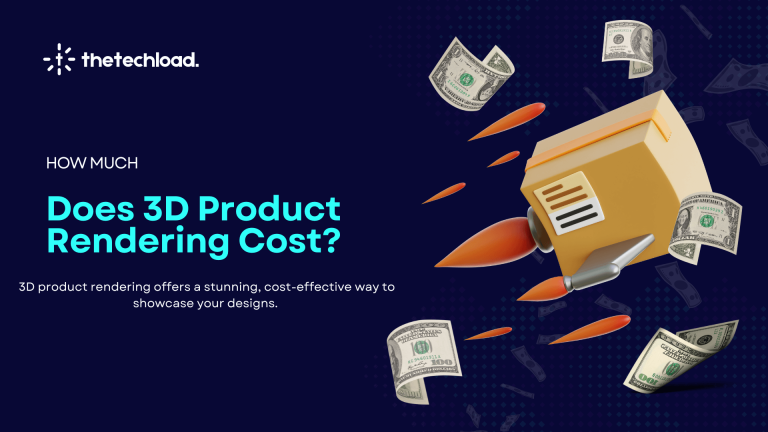In the fast-paced world of online sales, 3D product rendering has become a game-changer, revolutionizing how businesses market and showcase their products. This advanced digital technique is no longer just an option; it is essential for companies looking to stay ahead in the competitive e-commerce landscape.
From photorealistic product imagery to virtual product prototyping, 3D rendering offers an immersive shopping experience that captivates potential buyers and boosts conversions.
With the rise of modern design solutions and the increasing demand for high-quality visuals, businesses must embrace digital product visualization to meet consumer expectations.
This article will explore the benefits of 3D product rendering, highlight its impact on e-commerce, and explain why it is a crucial investment for brands looking to thrive in 2025 and beyond.
What is 3D Product Rendering?
3D product rendering is creating realistic digital images of a product using computer software. Instead of taking photos of an item, designers build a 3D model, add textures and colors, adjust lighting, and generate high-quality images.
This method allows businesses to showcase products from different angles, highlight key details, and create multiple variations without physical samples. It is widely used in e-commerce, advertising, and product design to attract customers and improve sales.
Top 7 Powerful Benefits of 3D Product Rendering
Here are seven powerful benefits of 3D Product Rendering that will convince you to invest in this remarkable technology.
- Accurately describes the products
- It is faster and cost-effective
- Shows the product under perfect lighting
- Better Communication with Clients
- Increased Customization Options
- Consistency in Your Branding
- Improves customer satisfaction and enhances brand credibility
1. Accurately Represents Products
One of the most significant benefits of 3D product rendering is its ability to showcase products accurately. Every detail, from textures and materials to colors and shapes, can be presented clearly and realistically.
Customers can view products from different angles, zoom in on more information, and better understand the product’s features before purchasing.
This level of accuracy builds trust between the brand and the customer. When buyers see a product in high detail, they feel more confident about their purchase.
This also helps reduce confusion and ensures that customers know exactly what they are getting, leading to fewer returns and increased satisfaction.
2. Faster and More Cost-Effective
With 3D rendering, businesses can quickly create product images without needing physical samples. Changes can be made in minutes, allowing for faster product development and marketing. Everything can be done digitally without extra costs, whether adjusting a color, changing a design, or showcasing different product versions.
This efficiency means businesses can save money while still producing high-quality visuals. Instead of waiting for manufacturing and photoshoots, products can be designed, modified, and presented instantly, speeding up the sales process and helping brands stay ahead of the competition.
3. Perfect Lighting for Every Image
Lighting plays a significant role in making a product look appealing. 3D rendering allows designers to create the perfect lighting for every product, ensuring that all details stand out clearly. Shadows, reflections, and highlights can be adjusted to make the product look attractive.
Unlike real-world lighting, which can be hard to control, digital lighting can be modified easily to match different moods and styles. Whether a brand wants a soft, elegant glow or a bright, sharp look, 3D rendering offers complete control over lighting, making every product image look professional and engaging.
4. Better Communication with Clients
Clear visuals help businesses communicate their ideas effectively. 3D rendering allows companies to present products in a way that is easy to understand. Instead of relying on sketches or descriptions, clients can see a realistic representation of the final product.
This helps avoid misunderstandings and ensures that everyone is on the same page. Clients can request changes and see them applied instantly, making the development process smoother and more efficient. This improved communication builds trust and satisfaction, leading to better collaboration and stronger business relationships.
5. Increased Customization Options
One of the best benefits of 3D product rendering is the unlimited customization options available for businesses to create unique and personalized visuals. The flexibility of 3D software allows for changes to be made quickly and easily, making it possible to showcase the same product in different colors, textures, and variations without additional photoshoots.
This level of customization is particularly valuable for industries such as interior design and fashion, where every product can be tailored to the individual needs and preferences of the client.
With 3D rendering, businesses have the power to offer a truly personalized experience for their customers, setting them apart from competitors.
6. Consistent Branding Across Platforms
A strong brand identity is essential for business success. With 3D rendering, companies can maintain a consistent look and feel across all marketing channels. Every product image can be designed to match the brand’s style, ensuring a professional and unified appearance.
Consistency helps customers recognize and trust a brand. When all product visuals look polished and uniform, it strengthens the brand’s reputation and makes marketing campaigns more effective. This leads to better brand loyalty and higher engagement from customers.
7. Enhances Customer Satisfaction and Brand Credibility
A high-quality shopping experience leads to happy customers. 3D product rendering provides detailed and realistic visuals, helping customers make informed decisions. When they know exactly what to expect, they are more likely to be satisfied with their purchase.
Satisfied customers are likelier to leave positive reviews, recommend the brand to others, and make repeat purchases. This improves brand credibility and trust, making it easier for businesses to attract and retain loyal customers.
By investing in 3D rendering, companies can create a better buying experience that keeps customers returning.
The Future of Product Marketing: 3D Rendering Trends in 2025
As technology evolves, so do the ways businesses market their products. The future of product marketing is increasingly visual, and 3D rendering trends in 2025 point toward even more realistic and interactive experiences.
From augmented reality (AR) shopping experiences to real-time product customization, 3D rendering will continue to shape how consumers interact with products online.
Conclusion
The benefits of 3D product rendering are undeniable. This technology transforms how businesses showcase and sell their products online, from cost savings and modern design solutions to better customer engagement.
Companies that invest in 3D rendering for product launches and marketing will gain a competitive edge with 3D technology, positioning themselves for success in the digital marketplace.
If you want to stay ahead in product marketing, now is the time to embrace 3D product rendering. Elevate your brand, enhance customer satisfaction, and drive more sales with cutting-edge 3D visualization techniques.
3D Product Rendering: FAQs
3D rendering eliminates the need for physical prototypes, costly photoshoots, and logistics expenses. Businesses save on materials, storage, and transportation while being able to make design changes instantly without incurring additional costs.
Yes! The demand for 3D rendering services is growing across industries. Companies in automotive design, healthcare, fashion, and interior design are adopting this technology for better product visualization and client presentations.
Absolutely. 3D rendering enhances product listings with photorealistic images, leading to higher engagement rates, better conversions, and increased customer trust. Interactive 3D models allow users to explore products in detail, improving the shopping experience.
Yes. 3D renderings are highly versatile and can be used on e-commerce websites, social media, print advertisements, and digital campaigns, ensuring a consistent brand image across all platforms.





One Response